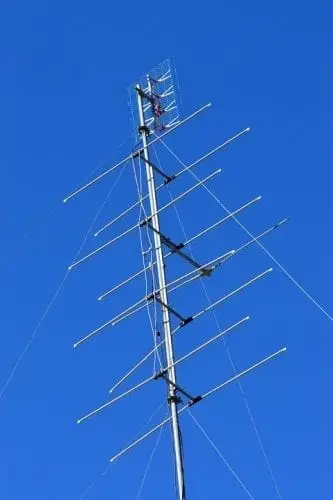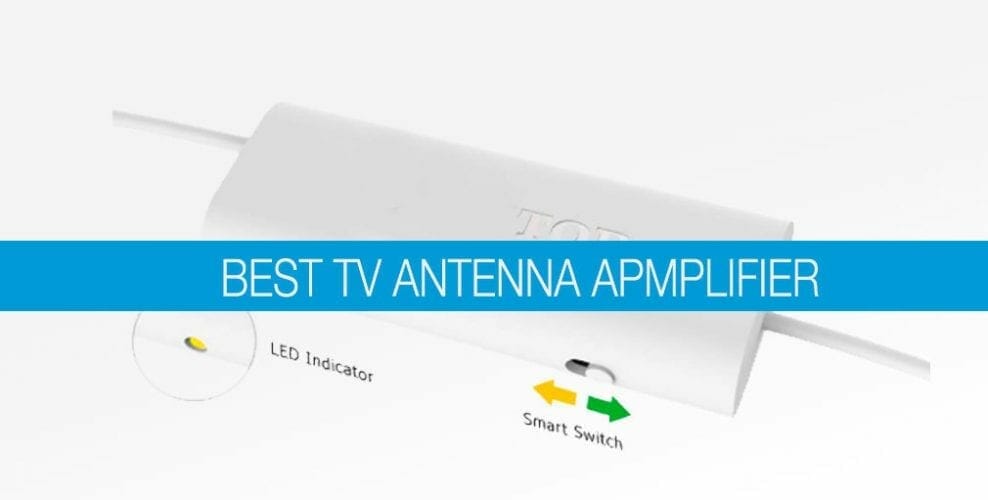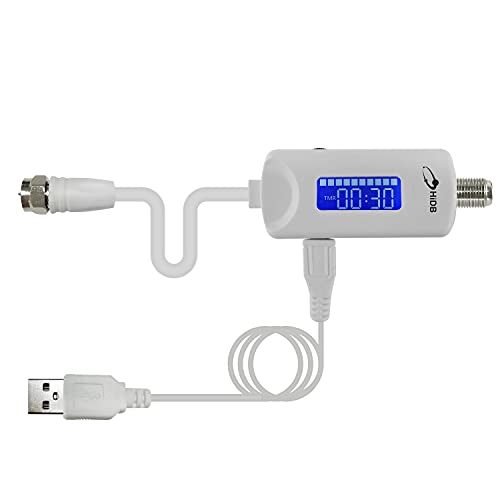When you’re using a TV antenna yet aren’t satisfied with the quality of your experience, chances are you need an antenna amplifier. An amplifier will increase the strength of the signal.
However, in your quest for the best TV antenna amplifier, there are many factors to consider. Do you need a preamplifier or a distribution amplifier? How powerful should the amplifier be? Do you get an internal or an external one?
To make things even more difficult, even if you answer all of these questions, you’re left with a huge number of options that you’ll need to pick and choose from. Not all of them are made equal, and some may not make the difference you expect. We’ve got a couple of options you’ll want to look at. They’re all great amplifiers from respectable manufacturers and will make quite a difference.
Best TV Antenna Amplifiers
We've got 7 options for you that have all performed admirably, and they're all great for some specific scenario.
Low on time? Heres a quick roundup of our top 3 picks and why you need them!
Product | Photo | Cost | Gain | Pros | Link |
*Best Overall | $$$ | 16dB | Great all-round pick with a high gain and very low noise figure | ||
#2. Winegard LNA-100 *Best for indoor antennas | $$$$ | 20dB | If you're only using an indoors antenna, this is the best choice for you | ||
*Best budget option | $ | 20dB | A great pick for the budget-oriented users |
1. ANTOP Smartpass Amplifier
The best overall antenna amplifier
The 1byone HDTV antenna is perfect for just about anyone, with an excellent range and great bad weather performance.
Our top pick is a bit surprising, as it’s one of the cheaper options on our list, yet performs admirably. It’s made by ANTOP, and it comes with their Smartpass technology that lets you switch on the amplifier for better reception, or switch it off to avoid overloading your tuner. The clear circuit technology will reduce signal dropout and give you a longer range and cleaner picture. Note, however, that this amplifier only works with a non-amplified antenna.
To add to the features, there’s a built-in 4G LTE filter which blocks both 3G and 4G wireless signals. They’re known to interfere quite a bit with TV antennas, but you won’t have that problem here. It has a maximum gain of 16dB, which is plenty, and a noise figure of less than 2dB, which is excellent. It’s also compatible with both VHF and UHF antennas, so you won’t be missing out.
The amplifier comes with all the hardware and cables you’ll need to get it up and running, and it’s really simple to set up. Considering all the features you’re getting, and of course the price, this is one that’s very hard to beat. Over here we have the Antop smart boost review.
2. Winegard LNA-100
The best indoor antenna amplifier
If you need an amplifier for your indoor antenna, the Winegard LNA-100 is hard to beat
Our runner up comes courtesy of Winegard, and it’s their LNA-100 TV antenna amplifier. It’s a great alternative to our top pick, and it’s made to enhance the signal of just about any non-amplified antenna. One thing to know, though, is that it is made for indoor antennas.
It has Winegard’s amplified clear circuit technology with an extremely low noise figure of around 1dB, which is miles ahead of most of the competition. The typical gain is also 20dB, which means that it can get signals that you could barely receive, and make them into a great viewing experience.
If you have a non-amplified indoor antenna, this is one of the best options. Even though it’s a bit pricier, it has good gain and an incredibly low noise figure, making it definitely worth its asking price.
3. TV Antenna Amplifier, 25dB High Gain Signal Booster
The budget-oriented top pick
Even though the price differences aren't that big, the 1byone is definitely our budget winner
1byone is a very reputable player in the antenna game, and they also have some excellent amplifiers as well. This specific model is extremely easy to set up and allows you to significantly boost your antenna’s signal.
It has a 20dB gain, which is fairly high. This is why 1byone don’t recommend using the amplifier if you live close to a broadcast tower – it can easily overpower your tuner and cause damage. The downside to it, and the reason why its third on our list and not higher, is the fact that it comes with a noise figure of around 4dB. This is far from low, and may cause more interference than you’d like.
On the other hand, the clear circuit technology will give you more channels and a better range than you’d get with just your antenna, and you’re also getting a power saving USB power supply. All things considered, it’s a great option for the budget oriented users that want 10 to 15 miles of extra range and a few more channels.
4. Channel Master CM3414 4-port
The best distribution amplifier for people who have more than a single TV set
We’ll talk about distribution amplifiers in a bit, but the CM3414 is a great example. It has four output ports, with 7.5dB gain per output. If you live in a household with multiple TV sets, this can mean that you have a significant quality loss. The CM3414 can help with this. It won’t only counter the effects, but also make things even better.
It has a forward frequency range of -54 to 1002 MHz, and a return path frequency range of -5 to 42 MHz. You can use it in CATV, HDTV, off-air, analog and digital RF distribution, making it a fairly versatile option. If you’re in need of a distribution amplifiers, this is the one to get, and it doesn’t cost too much.
Many TV antennas suffer from a popular issue lately – mobile broadcast towers interfere with their 3G and LTE signals. The Channel Master LTE Filter is meant to combat this, especially when you have pixilation or channel loss.
This is a highly effective filter, especially for US users, where frequencies above UHF channel 51 are used for services other than TV broadcasting. Note that this won’t really amplify any of the signals you are receiving – you may still need a preamplifier or an amplifier for that. However, you can connect it between the antenna and the amplifier, and it will filter the problematic signals, making the amplifier more effective.
6. GE Indoor HD Digital TV Antenna Amplifier
If you're on a really really tight budget and have two antennas and TV sets, this might be ideal for you
Antenna users on a budget will love this 2-pack from EEEKit, as you get two amplifiers for less than the price of one higher quality one. If you have multiple antennas and want to amp the signal on both, without spending a lot, this could be a good option.
The amplifiers have a very high gain of 25dB, but unfortunately, that also comes with a noise figure of around 4dB. This is less than impressive, but it will get the job done. They’re powered via USB, so they won’t take up outlets, and they’re pretty small. If you’re on a budget, they’re a great pick.
7. PCT 1-port Bi-Directional Amplifier
The PCT 1-Port amplifier is great if you want to reduce pixilation and snow, and doesn't cost too much
Last but not least, we have a somewhat expensive, yet very good amplifier – the PCT 1-port amplifier. It significantly reduces pixilation and snow when you’re watching a channel with a weak TV signal, and it’s compatible with just about any over-the-air antenna signal.
You’ll be getting 15dB of signal boost, which is plenty, but still not too much so it overpowers your tuner. One thing to note though – this isn’t compatible with satellite TV, and it will cause more harm than good if used with one.
If you’re using splitters or long cable runs, you’ll want to install the PCT before them, as this is what gets you the best results.
The buying guide
If you took a look at our options, you’re noticing that they vary greatly, and this may make choosing one a bit difficult. Let’s take a look at the key things to know, so you can choose the right amplifier for you.
Amplifiers vs. distribution amplifiers vs. preamplifiers
This is the first question you’ll want to ask yourself. There are three types of amplifiers, and they’re all made for a different scenario. An amplifier generally amplifies the signal in general, but preamplifiers and distribution amplifiers are made for specific situations.
Preamplifiers are used to compensate for the loss of a signal due to a long cable run. These situations often happen in large houses, or areas where you have quite a lot of cable going from the antenna to the TV set. When you have a signal that is weak, a long cable can make watching TV impossible. If this is the type of issue you have, a preamplifier is the device you need. They’re commonly placed outdoors, right next to the antenna itself.
A distribution amplifier is used in a completely different scenario. When you’ve got multiple TVs or receivers that all get their signal from a single antenna, you’re losing quite a bit. For example, a two-way splitter results in a loss of around 4dB of signal, whereas a three or four-way splitter will result in losses of around 8dB. You’re in a hotel? An 8-way splitter loses around 14-15dB. A distribution amplifier will increase the signal to overcome any losses that may come out due to the use of splitters.
Even though the two types are distinctly different and choosing which one you need shouldn’t be difficult, there’s always the scenario where you actually need both. Imagine this – your antenna is on a 100-feet tall tower. You’re 30 feet away from the house, and you have four TVs inside your house that all need a signal from the antenna. Only if you get both will you be able to watch TV on all of them, without noticeable quality drops.
The gain is very important
When you’re looking at amplifier specifications, you’ll come across a variety of numbers. Yet, none of them are as important as the gain. We already spoke about signal loss due to cable length or splitters, and you’ll want enough gain to compensate for that.

For example, if you have 100 feet of cable, with an RG6 cable, that’s more or less 8dB of loss. To compensate for that, you’ll want an amp that is at least 8dB, or stronger. They usually range from 12 to 30dB, so get what’s most appropriate for you.
One thing to know, though, is that a higher-gain amp isn’t always better. If you have a 15dB loss, and you use a 30dB amp, that can be counterproductive and can overdrive your tuner with too much signal. Your safest bet would be to get a rough estimate on your signal loss (or an exact number, which is even better), and get an amp that has 2-3dB more than that.
Consider the noise figure
When you have a digital signal, the noise figure is just as important as the gain is. Whenever you add any kind of amplifier to a system, you’re introducing a certain amount of noise. The higher the noise figure is, the lower the tuners sensitivity to picking up the signal is. Therefore, you’ll want to get something with a low noise figure, for example 2dB. Something with a noise figure that’s 4-6dB is something you should definitely stay away from if possible.
Make sure to match the signal type
With your antenna, it’s either receiving UHF or VHF signals, or both. When you’re buying the best TV antenna amplifier, you’ll want to match your antenna. For example, if your antenna receives both, you’ll want an amplifier that passes both as well. Using such an antenna with an amp that’s only UHF or only VHF will result in the other frequency being blocked. Most of the amplifiers on the market actually pass all frequencies, but make sure you read the specs well.
Consider an amplifier with auto gain control
We spoke about gain, and how too much can actually overdrive your tuner. An amplifier with auto gain control will reduce the gain of a signal that is too strong. You have some amplifiers that have advanced auto gain control that amplifies weak signals as much as possible, yet limits the strong ones to prevent any potential damage.
Wrapping things up
At the end of the day, if you have weak signal, it is more than likely that you can solve it with an amplifier. We hope to have cleared all the terminology that you’ll come across when looking for the best TV antenna amplifier. All that’s left for you to do is to choose the one from our list that is most suitable for you, and set it up. Voila, no more weak signal issues!








